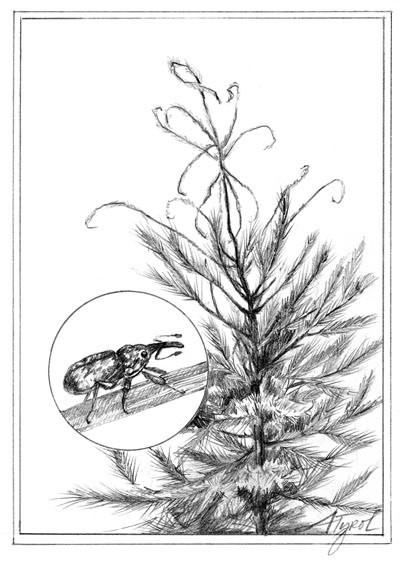
The eastern white pine is the tallest tree in this part of North America, with the biggest specimens getting up near 200 feet. They can live for 250 years or more. A truly big one is jaw-droppingly impressive.
Unfortunately, many never reach their full potential. Dubbed pasture pines, cabbage pines, or wolf trees, these squat multi-stemmed trees look like shrubs on steroids. Not for them the soaring magnificence of a robust, healthy pine. I’ve got plenty of them in the woods in back of my house. When I look at them, I just sigh.
You can blame it all on a native insect: the white pine weevil, Pissodes strobi.
“It’s an opportunist. It’s probably on every acre of pine land that there is,” said Kyle Lombard, forest entomologist with the New Hampshire Division of Forests and Lands, of the weevil. “The thing is it doesn’t kill the tree. It’s not like blister rust in that way. It just ruins its economic value to the landowner.”
The white pine weevil is a drab, nondescript beetle about a quarter of an inch long, with a serious-looking snout. The adults overwinter under trees and emerge in spring to fly or climb to the tops of pines or other trees – they prefer white pine but they’ve been known to damage 20 other species of conifer as well. They lay eggs in holes they cut in the bark just below the leading, topmost shoot. When the eggs hatch, the larvae feed beneath the bark, girdling the shoot, which turns brown and droops, looking like a shepherd’s crook. The larvae pupate beneath the bark in a chip cocoon, emerging as adults in summer.
The tree compensates for the death of the leader by self-selecting a branch, or branches, as the new leader. Normally, the leader produces hormones that keep the lower branches from growing upwards, but when it’s gone, the nearest side branches all turn up, competing with one another for dominance; this results in a forked main stem. Trees that get “weeviled” year after year end up with a multitude of “leaders” and no real trunk. They look like tortured candelabra.
Weevils like a nice, thick, juicy leader on a tree that’s growing where the sun warms it in late April or early May when the females are looking for a good spot to lay their eggs, said Lombard. Trees growing in fields are prime targets. Half a century ago, the area in back of my house was an old field, now it’s a pasture pine party.
With the decline of agriculture in New England, fields were abandoned and reverted to forest. White pines were early colonizers and were weeviled by the zillions. Many of these crippled pines still stand. In fact, it occurs to me that there are people who may not have seen a truly impressive, straight white pine. Instead, they assume that pasture pines are the norm for the species. Sigh.
Even today, if you’re trying to establish a white pine stand in an open field, your seedlings are “pretty much going to get hammered, 100 percent,” said Lombard.
On the other hand, genetics might be on your side, said Lombard. “If the seed source happens to be one of those that produces a thin leader, you won’t see much in the way of damage.” But he said he wouldn’t count on it: the seed sources for white pines in the northeast are from all over the world, and most grow a leader that is “more than suitable for white pine weevil.”
If you can, start your white pines under an overstory of hardwood trees to shade them from that leader-warming sun, said Lombard. This forestry technique, known as shelterwood, was invented for exactly that reason, he said. “All you have to do is keep a lid on the white pines for a while and you’re good to go.”
For ornamental trees planted in the open, pruning infected leaders and burning them is one way to cut down on numbers of the beetles and removing all but the strongest competing branch will help the tree reorient itself. Insecticides kill the adult beetles, but it’s crucial to choose the right one and apply it at the right time in early spring. You really have to douse the top of the tree.
If, like me, you have a lot of older pasture pines soaking up sun in your woodlot, well, they’re not worth much. Loggers and sawyers shun them, Lombard said. I could have them chipped for biomass. “Then again, lots of people just girdle them with a chainsaw and leave them for the woodpeckers to enjoy,” he said.


Discussion *